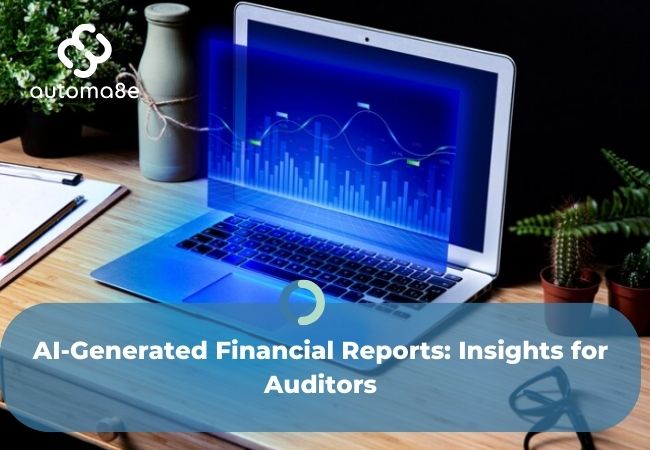Navigating the complexities of AI-generated financial statements demands a strategic approach for auditors. Overcoming these challenges involves embracing a set of comprehensive guidelines tailored to the dynamic landscape of AI technology in financial reporting.
In this blog, we’ll explore:
- Master the Technological Landscape
- Verify Data Integrity
- Rigorous Algorithm Testing
- Blend Automation with Human Judgment
- Stay Ahead of Regulatory Changes
- FAQs About AI-Generated Financial Reports
- Conclusion
Here’s a detailed roadmap to empower auditors in this transformative era:
Master the Technological Landscape:
Gain a profound understanding of the AI technologies underpinning financial statement generation. Auditors need to be well-versed in the intricacies of these systems to effectively evaluate associated risks and ensure a robust audit process.
Verify Data Integrity:
Ensure the reliability and accuracy of data sources feeding into AI systems. Auditors play a pivotal role in scrutinizing data inputs, safeguarding the foundation upon which AI-generated financial reports rely. Upholding data quality is paramount for maintaining the overall accuracy of financial statements.
Rigorous Algorithm Testing:
Conduct meticulous testing on the algorithms driving AI systems. Through simulations and historical tests against known outcomes, auditing teams can assess algorithm performance. This thorough examination is crucial for validating the reliability and predictive capabilities of AI-generated financial reports.
Blend Automation with Human Judgment:
While automation enhances efficiency, human judgment remains indispensable. Auditors should seamlessly integrate their expertise to assess complex transactions and identify potential errors that automated systems may overlook. The synergy of technology and human insight ensures a comprehensive and accurate audit process.
Stay Ahead of Regulatory Changes:
The regulatory landscape surrounding AI and financial reporting is in constant flux. Auditors must stay vigilant, continually updating their knowledge to align with evolving compliance requirements. Staying ahead of regulatory changes ensures audits remain not only accurate but also fully compliant with the latest standards.
In the realm of AI-generated financial statements, auditors armed with these guidelines can confidently navigate the challenges, ensuring a seamless blend of technology and human expertise. This proactive approach positions auditors to thrive in an era where innovation and compliance go hand in hand.
AI-generated financial statements pose a unique challenge for auditors in adapting to the evolving landscape of artificial intelligence in finance.
Auditors should gain a solid understanding of the underlying AI technologies, ensuring they can evaluate and manage risks effectively.
Ensuring accurate and reliable data sources is paramount for auditors, as it directly impacts the overall accuracy of AI-generated financial statements.
Conducting thorough testing on the algorithms powering AI systems is essential. Simulations and historical tests help assess performance and reliability.
While automation enhances efficiency, human judgment remains indispensable for assessing complex transactions and identifying potential errors overlooked by automated systems.
Auditors must stay vigilant and continually update their knowledge to align with evolving compliance requirements in the dynamic landscape of AI and financial reporting.
Conclusion:
In the ever-evolving landscape of financial reporting, auditors are at the forefront of mastering the challenges posed by AI-generated financial statements. As we conclude this journey through the intricacies of navigating AI complexities, it becomes evident that auditors must not merely adapt but thrive in this transformative era.
The roadmap presented – from mastering the technological landscape to staying ahead of regulatory changes – serves as a guide for auditors seeking to harness the potential of AI while maintaining the integrity of financial reporting. As auditors gain a profound understanding of AI technologies, scrutinize data inputs, conduct rigorous algorithm testing, and seamlessly blend automation with human judgment, they position themselves as architects of a robust and accurate audit process.
The synergy between technology and human insight emerges as a critical element in ensuring a comprehensive audit, where efficiency meets precision. The call to stay ahead of regulatory changes echoes the necessity for auditors to be vigilant, continually updating their knowledge to align with the dynamic compliance requirements in the AI and financial reporting realm.
Armed with these comprehensive guidelines, auditors are not just adapting to change; they are proactively shaping the future of financial reporting. This proactive approach positions auditors to thrive in an era where innovation and compliance go hand in hand, ultimately contributing to the overarching goal of financial transparency and accuracy in the age of AI-generated financial statements. As auditors embrace this transformative journey, they pave the way for a new standard of excellence in the intersection of technology and financial scrutiny.
About Automa8e:
Automa8e emerges as a transformative force, not only revolutionizing AI-driven financial reporting but also setting a higher standard in transparency and accountability. As auditors navigate the complexities of accuracy, compliance, and transparency in the realm of AI-generated financial statements, Automa8e stands as a steadfast ally. With its cutting-edge technology and commitment to excellence, Automa8e paves the way for a new era of financial reporting, where innovation and accountability go hand in hand. As auditors embrace Automa8e, they embark on a journey of financial excellence, confident in the accuracy, compliance, and transparency of AI-powered unaudited financial reports.
